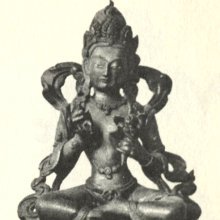Durangama, Dūraṅgama, Dūraṅgamā: 6 definitions
Introduction:
Durangama means something in Buddhism, Pali. If you want to know the exact meaning, history, etymology or English translation of this term then check out the descriptions on this page. Add your comment or reference to a book if you want to contribute to this summary article.
Images (photo gallery)
In Buddhism
Mahayana (major branch of Buddhism)
Source: Wisdom Library: Maha Prajnaparamita SastraDūraṅgamā (दूरङ्गमा) or Dūraṅgamābhūmi is another name for Dūraṃgamā, referring to the “far-going bhūmi” and represents one of the ten Bodhisattva grounds (bodhisattabhūmi), according to the Daśabhūmikasūtra, or Daśabhūmīśvara, as mentioned in the 2nd century Mahāprajñāpāramitāśāstra chapter 52.—Dūraṅgamā or Dūraṃgamā-bhūmi is also known as “riṅ du soṅ ba, chen jou or yuan hing”.

Mahayana (महायान, mahāyāna) is a major branch of Buddhism focusing on the path of a Bodhisattva (spiritual aspirants/ enlightened beings). Extant literature is vast and primarely composed in the Sanskrit language. There are many sūtras of which some of the earliest are the various Prajñāpāramitā sūtras.
Tibetan Buddhism (Vajrayana or tantric Buddhism)
Source: Wisdom Library: Tibetan BuddhismDūraṅgama (दूरङ्गम) is the name of a Tathāgata (Buddha) mentioned as attending the teachings in the 6th century Mañjuśrīmūlakalpa: one of the largest Kriyā Tantras devoted to Mañjuśrī (the Bodhisattva of wisdom) representing an encyclopedia of knowledge primarily concerned with ritualistic elements in Buddhism. The teachings in this text originate from Mañjuśrī and were taught to and by Buddha Śākyamuni in the presence of a large audience (including Dūraṅgama).
Source: archive.org: The Indian Buddhist IconographyDūraṅgamā (दूरङ्गमा) or Dūraṅgamābhūmi refers to one of twelve Bhūmi Goddesses, as commonly depicted in Buddhist Iconography, and mentioned in the 11th-century Niṣpannayogāvalī of Mahāpaṇḍita Abhayākara.—Her Colour is green; her Symbol is a double-vajra on double-lotus; she has two arms.
Dūraṅgamā is described in the Niṣpannayogāvalī (dharmadhātuvāgīśvara-maṇḍala) as follows:—
Source: MDPI Books: The Ocean of Heroes“Dūraṅgamā is green like the sky and holds in her left hand the viśvavajra (double thunderbolt) on a viśvapadma (double conventional lotus)”.
[These twelve bhūmis [viz., Dūraṅgamā] are two-armed and hold in the right hand the vajra and in the left their own weapons or signs.]
Dūraṅgamā (दूरङ्गमा) refers to “far-reaching”, according to the 10th-century Ḍākārṇava-tantra: one of the last Tibetan Tantric scriptures belonging to the Buddhist Saṃvara tradition consisting of 51 chapters.—Accordingly, [while explaining the fire-circle (agnicakra)]: “[...] [Every Yoginī on this circle is of] the Far-Reaching Level (dūraṅgamā-bhūmi) [bhūmi dūraṅgamā caiva], lives in the sixth continent, is said [to dwell in] the melāpaka (“meeting”) [holy site], and has the nature of the wisdom and means. She indeed always [constitutes] a power circle and is to be understood as a beautiful woman [matching her consort hero resembling] her in appearance. All [deities on the circles] such as the Adamantine Circle are [placed] clockwise and anticlockwise. [...]”.

Tibetan Buddhism includes schools such as Nyingma, Kadampa, Kagyu and Gelug. Their primary canon of literature is divided in two broad categories: The Kangyur, which consists of Buddha’s words, and the Tengyur, which includes commentaries from various sources. Esotericism and tantra techniques (vajrayāna) are collected indepently.
General definition (in Buddhism)
Source: Wisdom Library: Dharma-samgrahaDūraṅgamā (दूरङ्गमा, “far-gone”) or Dūraṅgamābhūmi refers to the seventh of the “ten stages of the Bodhisattva” (bhūmi) as defined in the Dharma-saṃgraha (section 64). The Dharma-samgraha (Dharmasangraha) is an extensive glossary of Buddhist technical terms in Sanskrit (e.g., dūraṅgamā). The work is attributed to Nagarjuna who lived around the 2nd century A.D. Arciṣmatī is also included in the “thirteen stages of the Bodhisattva” (trayodaśa-bhūmi).
Languages of India and abroad
Pali-English dictionary
Source: BuddhaSasana: Concise Pali-English Dictionarydūraṅgama : (adj.) going afar.

Pali is the language of the Tipiṭaka, which is the sacred canon of Theravāda Buddhism and contains much of the Buddha’s speech. Closeley related to Sanskrit, both languages are used interchangeably between religions.
See also (Relevant definitions)
Starts with: Durangamabhumi, Turankamam.
Full-text: Durangamabhumi, Bhumi, Bodhisattvabhumi.
Relevant text
Search found 2 books and stories containing Durangama, Dūraṅgama, Dūraṅgamā; (plurals include: Durangamas, Dūraṅgamas, Dūraṅgamās). You can also click to the full overview containing English textual excerpts. Below are direct links for the most relevant articles:
Dhammapada (Illustrated) (by Ven. Weagoda Sarada Maha Thero)
Verse 37 - The Story of Monk Saṅgharakkhita < [Chapter 3 - Citta Vagga (Mind)]
Maha Prajnaparamita Sastra (by Gelongma Karma Migme Chödrön)
Bhūmi 7: the far-gone ground (dūraṃgamā / dūraṅgamā) < [Chapter XX - (2nd series): Setting out on the Mahāyāna]

